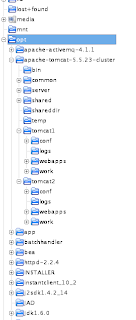This posting splitted because somehow blogspot just cut it. I don't know why but when I previewed the posting, blogspot just cut the postings, so I splitted it into 2 parts.
Ok, now we create workers.properties file.
onty@phoenix:/opt/httpd-2.2.4$ vi conf/workers.properties
\------------------------------------------------------------------------------------
worker.list=router,jkstatus
# Define a worker using ajp13
worker.worker1.port=8009
worker.worker1.host=localhost
worker.worker1.type=ajp13
worker.worker1.lbfactor=1
# Define prefered failover node for worker1
worker.worker1.redirect=worker2
# Define another worker using ajp13
worker.worker2.port=8009
worker.worker2.host=localhost
worker.worker2.type=ajp13
worker.worker2.lbfactor=1
# Define the LB worker
worker.router.type=lb
worker.router.balance_workers=worker1,worker2
# Define the status worker
worker.jkstatus.type=status
\------------------------------------------------------------------------------------
This file defines all our workers. Our 'router' worker will be a load balancer worker for other workers, including worker1 and worker2.
Now, we install (unzip, exactly) our apache. We use apache-5.2.23. We will modify the directory structure little bit, as shown like this.
 Give attention to tomcat1 and tomcat2 directory, and also directories inside it.We will use 2 instance of tomcat1 and tomcat2 as worker 'worker1' and 'worker2'. We also need to configure each server.xml in tomcat1 and tomcat2 so that they're not using the same port.
Give attention to tomcat1 and tomcat2 directory, and also directories inside it.We will use 2 instance of tomcat1 and tomcat2 as worker 'worker1' and 'worker2'. We also need to configure each server.xml in tomcat1 and tomcat2 so that they're not using the same port.
Tomcat1 :
Server port="8005" shutdown="SHUTDOWN"
..
..
Connector port="8009"
enableLookups="false" redirectPort="8443" protocol="AJP/1.3"
..
..
Connector port="8080" maxHttpHeaderSize="8192"
maxThreads="150" minSpareThreads="25" maxSpareThreads="75"
enableLookups="false" redirectPort="8443" acceptCount="100"
connectionTimeout="20000" disableUploadTimeout="true"
Tomcat2 :
Server port="9005" shutdown="SHUTDOWN"
..
..
Connector port="9009"
enableLookups="false" redirectPort="8443" protocol="AJP/1.3"
..
..
Connector port="8080" maxHttpHeaderSize="8192"
maxThreads="150" minSpareThreads="25" maxSpareThreads="75"
enableLookups="false" redirectPort="8443" acceptCount="100"
connectionTimeout="20000" disableUploadTimeout="true"
One more thing, we need to create startup and shutdown file for each tomcat instance. We call it start1.sh, start2.sh, stop1.sh, stop2.sh
start1.sh
#!/bin/bash
export CATALINA_BASE=/opt/apache-tomcat-5.5.23-cluster/tomcat1
export JAVA_HOME=/opt/jdk1.6.0
./startup.sh
start2.sh
#!/bin/bash
export CATALINA_BASE=/opt/apache-tomcat-5.5.23-cluster/tomcat2
export JAVA_HOME=/opt/jdk1.6.0
./startup.sh
stop1.sh
#!/bin/bash
export CATALINA_BASE=/opt/apache-tomcat-5.5.23-cluster/tomcat1
export JAVA_HOME=/opt/jdk1.6.0
./shutdown.sh
stop2.sh
#!/bin/bash
export CATALINA_BASE=/opt/apache-tomcat-5.5.23-cluster/tomcat2
export JAVA_HOME=/opt/jdk1.6.0
./shutdown.sh
Basically, these file just aimed to setup environment variable named CATALINA_BASE to point which tomcat instance we want to start/stop.
Now, lets try our installation. Start both tomcat instance, and also start your httpd server. Point out the browser to http://localhost/tomcat-docs/ and see if the request handled correctly. Httpd will redirect the request so that can be served by tomcat. Also point the browser to http://localhost/jkmanager/. This context path shows us the Load Balancing status for our tomcat instance.
Feel free to drop any comments about this posting. Thanks, good luck trying !